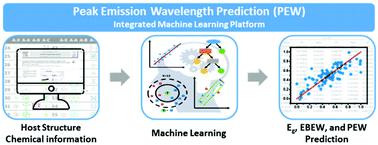当前位置:
X-MOL 学术
›
Inorg. Chem. Front.
›
论文详情
Our official English website, www.x-mol.net, welcomes your
feedback! (Note: you will need to create a separate account there.)
A data-driven approach to predicting band gap, excitation, and emission energies for Eu2+-activated phosphors
Inorganic Chemistry Frontiers ( IF 6.1 ) Pub Date : 2021-08-19 , DOI: 10.1039/d1qi00766a Chaewon Park 1 , Jin-Woong Lee 1 , Minseuk Kim 1 , Byung Do Lee 1 , Satendra Pal Singh 1 , Woon Bae Park 2 , Kee-Sun Sohn 1
Inorganic Chemistry Frontiers ( IF 6.1 ) Pub Date : 2021-08-19 , DOI: 10.1039/d1qi00766a Chaewon Park 1 , Jin-Woong Lee 1 , Minseuk Kim 1 , Byung Do Lee 1 , Satendra Pal Singh 1 , Woon Bae Park 2 , Kee-Sun Sohn 1
Affiliation

|
The prediction of excitation band edge wavelength (EBEW) and peak emission wavelength (PEW) for Eu2+-activated phosphors is intricate in practice, although a theoretical interpretation has been well established. A data-driven approach could be of great help for EBEW and PEW prediction. We collected 91 Eu2+-activated phosphors, the host structures of which exhibit a single activator site and the EBEW and PEW of which are available at the critical activator concentration. We extracted 29 descriptors (input features) that implicate the elemental and structural traits of phosphor hosts, and set up an integrated machine-learning (ML) platform consisting of 18 ML algorithms that allowed prediction of the EBEW and PEW as well as the DFT-calculated band gap (Eg). The acquired dataset involving 91 phosphors was insufficient for the 29-input-feature problem and the real-world data collected from the literature have a so-called dirty nature due to inaccurate, unstandardized experiments. Despite an unavoidable paucity of data and the dirty-data problems of real-world data-based ML implementation, we obtained acceptable holdout dataset test results for PEW predications such as R2 > 0.6, MSE < 0.02, and test_R2/training_R2 > 0.77 for four ML algorithms. The EBEW and Eg predictions returned slightly better test results than these PEW examples.
中文翻译:

一种预测 Eu2+ 激活磷光体的带隙、激发和发射能量的数据驱动方法
Eu 2+激活的磷光体的激发带边缘波长(EBEW)和峰值发射波长(PEW)的预测在实践中是复杂的,尽管已经很好地建立了理论解释。数据驱动的方法可能对 EBEW 和 PEW 预测有很大帮助。我们收集了 91 个 Eu 2+激活的磷光体,其主体结构表现出单个活化剂位点,并且其 EBEW 和 PEW 在临界活化剂浓度下可用。我们提取了 29 个涉及磷光体元素和结构特征的描述符(输入特征),并建立了一个由 18 个 ML 算法组成的集成机器学习 (ML) 平台,允许预测 EBEW 和 PEW 以及 DFT-计算的带隙 ( E g)。获得的包含 91 个磷光体的数据集不足以解决 29 个输入特征问题,并且由于不准确、不标准化的实验,从文献中收集的真实世界数据具有所谓的脏性质。尽管数据和基于数据的真实世界ML实施脏数据问题的不可避免的缺乏,我们获得了可接受的不渗透性的数据集的测试结果为PEW断言如ř 2 > 0.6,MSE <0.02,和TEST_ - [R 2 / training_ ř对于四种 ML 算法,2 > 0.77。EBEW 和E g预测返回的测试结果略好于这些 PEW 示例。
更新日期:2021-08-25
中文翻译:

一种预测 Eu2+ 激活磷光体的带隙、激发和发射能量的数据驱动方法
Eu 2+激活的磷光体的激发带边缘波长(EBEW)和峰值发射波长(PEW)的预测在实践中是复杂的,尽管已经很好地建立了理论解释。数据驱动的方法可能对 EBEW 和 PEW 预测有很大帮助。我们收集了 91 个 Eu 2+激活的磷光体,其主体结构表现出单个活化剂位点,并且其 EBEW 和 PEW 在临界活化剂浓度下可用。我们提取了 29 个涉及磷光体元素和结构特征的描述符(输入特征),并建立了一个由 18 个 ML 算法组成的集成机器学习 (ML) 平台,允许预测 EBEW 和 PEW 以及 DFT-计算的带隙 ( E g)。获得的包含 91 个磷光体的数据集不足以解决 29 个输入特征问题,并且由于不准确、不标准化的实验,从文献中收集的真实世界数据具有所谓的脏性质。尽管数据和基于数据的真实世界ML实施脏数据问题的不可避免的缺乏,我们获得了可接受的不渗透性的数据集的测试结果为PEW断言如ř 2 > 0.6,MSE <0.02,和TEST_ - [R 2 / training_ ř对于四种 ML 算法,2 > 0.77。EBEW 和E g预测返回的测试结果略好于这些 PEW 示例。











































 京公网安备 11010802027423号
京公网安备 11010802027423号